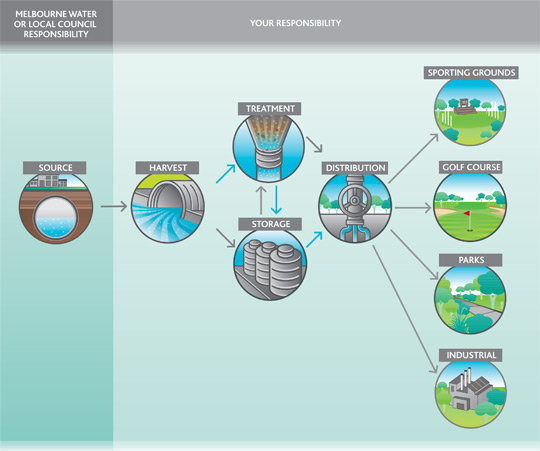Stormwater harvesting involves collecting, treating, storing and using stormwater runoff from urban areas. It differs from rainwater harvesting as the runoff is collected from drains rather than roofs.
Stages of stormwater harvesting
Urban stormwater harvesting schemes vary in characteristics, but have some typical stages as illustrated the diagram below.

Harvest
Stormwater is collected from a source – usually a drain – which belongs to either Melbourne Water or the local council.
Storage
Stormwater is temporarily held in above- or below-ground storages to balance supply and demand. Sometimes this can constrain a scheme, as costs and space restrictions can limit the volume of storage available.
Treatment
Water is then treated to reduce pathogen and pollution levels: at mechanical water treatment plants or natural systems such as wetlands.
Treatment depends on how the water is used and its quality, which varies according to where the water came from and how often it rains. The scheme manager is responsible for ensuring that water quality is fit for purpose and that any risks to public health and the environment are controlled.
Distribution
The treated stormwater is distributed to the area of use, such as sporting facilities, industrial complexes or wetlands.
Planning your stormwater harvesting scheme
A successful stormwater harvesting project requires input from several specialist sectors, including:
- stormwater management
- environmental management
- public health
Hydrological modelling may be needed to determine the appropriate storage means and capacity for the scheme. Sometimes a study may be required to assess environmental impacts at the source and receiving waterways downstream.
Licences
If the source of your stormwater is a Melbourne Water stormwater drain, you will need a licence to harvest stormwater. You’ll also need a licence to harvest stormwater anywhere within the Urban Growth Boundary.
Treatment and quality standards
Stormwater may need to be treated, depending on how it will be used. Treatment can be in the form of natural systems, such as wetlands, or mechanical water treatment plants.
There are no specific laws that dictate what stormwater can be used for or what quality standards it must meet. However, individuals and organisations responsible for stormwater schemes have a duty of care to make sure their scheme will not place people or the environment at risk.
The quality of stormwater and the associated management controls need to be proportional to the level of risk – the more likely it is that stormwater will place people or the environment at risk, the higher the water quality and more stringent the management controls need to be.
Environment Protection and Heritage Council (EPHC) guidelines
These guidelines establish the standards and best practice for protecting public health and the environment, and managing risks associated with stormwater use. They should be the basis for developing and managing a stormwater use scheme.